
The First and Only Weekly Online Fanzine Devoted to the Life and Works of Edgar Rice Burroughs
Since 1996 ~ Over 10,000 Webpages in Archive
Volume 0987
Presents
MOTES & QUOTES
ERB Newsmagazine 2002.11.

|
My recent e-mail to the editors of the National Post, Canada's national newspaper, has dragged my observations on the influence of Edgar Rice Burroughs into a dispute that has been making international headlines. Numerous follow-up phone calls from Toronto with requests for book cover
illustrations and for more info on ERB's stories have resulted in a front
page story in this morning's Post: The headline:
|
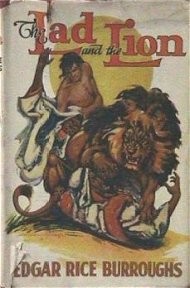
 |
Boy and beast on a boat?
Oldest idea in the world
Sarah Schmidt ~ National Post
Saturday, November 09, 2002
http://www.nationalpost.com/home/story.html?id={3A7EE136-A2F5-4457-A00C-AAB6A90F67FB}"It appears the plot of a boy on a boat with a beast is nearly a century old."
Fans of Edgar Rice Burroughs are shaking their heads at Brazilian author Moacyr Scliar's accusation this week that Montreal's Yann Martel stole the premise from him.
Burroughs, the famed creator of Tarzan, told a similar story in his The Lad and the Lion in 1914.
Inspired by archetypal religious imagery of people cast adrift with animals, most notably in the tale of Noah's Ark, and the literary tradition of the special bond between child and beast, as in Rudyard Kipling's The Jungle Book, Burroughs devoted a long chapter of his book to the boy and the lion drifting for years aboard a derelict boat.
Mr. Scliar's novel Max and the Cats, the story of a Jewish boy and a panther on a lifeboat, was published in 1981.
Mr. Martel's Life of Pi, the story of an Indian boy and a tiger on a lifeboat, has won this year's Booker Prize.
Mr. Scliar this week accused Mr. Martel of abusing his "intellectual property." He mused about taking legal action but then decided against it.
Besides The Lad and the Lion, Burroughs also wrote of a man-animal maritime adventure in his 1914 novel The Beasts of Tarzan. In this story, Tarzan, stranded on an island, survives with the help of a panther and an ape before the group escapes on a boat.
"It's ridiculous to say you can copyright ideas in literature. What hasn't been said? What hasn't been recycled?" said Bill Hillman, a professor of education at the University of Brandon and a Burroughs expert."Certainly Burroughs came up with just about any combination you could think of with man and beast."
Burroughs, author of more than 20 Tarzan novels, always maintained that the concept of an original literary idea defied logic.
"Burroughs himself said that there's nothing new under the sun and the best we can to is put new clothes on old ideas," said George McWhorter, curator of the Burroughs Memorial Collection at the University of Louisville.
His own blunt admission did not stop the accusations of plagiarism levelled against Burroughs, whose Tarzan books have been translated into more than 50 languages, have sold more than 20 million copies and have served as the basis for many movies.
Some of his contemporaries accused him of "stealing from Romulus and Kipling,'' Dr. McWhorter said.
"I guess we should also accuse Kipling of copying Romulus," Dr. McWhorter added mockingly.
Mowgli, Kipling's central character in The Jungle Book, written in 1894, was raised in the wild by wolves, just like the legendary founders of Rome, Romulus and Remus, who myth says were abandoned as infants and saved by a female wolf.
Marcus Boon, a professor of contemporary literature at York University in Toronto, said the spiral of accusations illustrates the absurdity of laying claim to an original idea in literature.
"These are sort of fundamental images and narratives within human culture," Dr. Boon said of the image of a person cast adrift with animals.
Dr. Boon said examples of the "ubiquity of the man-animals-raft image" in literature and film include French author Alfred Jarry's Exploits and Opinions of Dr. Faustroll, Pataphysician (1898). The story ends with the main character sailing away in a boat with a chattering ape.
Werner Herzog's 1972 classic movie Aguirre: Wrath of God, which tells the story of a 16th-century expedition in Latin America, ends with the main character on a boat with monkeys.
As is common in the literary world, Mr. Martel disclosed long ago that he was inspired by Mr. Scliar's plot in Max and the Cats, translated into English in 1990. "Books are constantly referencing other books," Dr. Boon said. "I'm sure Scliar's book has resonance with other books."
Carys Craig, a copyright specialist at Osgoode Hall Law School in Toronto, said the law accepts this long-standing practice.
"It's essential that people be free to develop upon and free to share ideas -- and that's a goal of copyright law....
* * *
For the rest of the story see:
http://www.nationalpost.com/home/story.html?id={3A7EE136-A2F5-4457-A00C-AAB6A90F67FB}
THE FRONTPAGE STORY GENERATED BY OUR ERB PROMOTION PROMPTED THIS
FOLLOW-UP STORY IN THE OTTAWA CITIZEN AND NATIONAL POST
Catch a tiger by the tale
Boys and beasts were storied long before the latest literary dust-up
http://www.canada.com/ottawa/ottawacitizen/story.asp?id={FBA658CF-888D-4406-B654-3244DB9A1E65}
Paul Gessell
The Ottawa Citizen
Tuesday, November 12, 2002Richard Parker is quite the literary gadfly. He first appeared, back in 1850, as a character in Edgar Allan Poe's creepy nautical tale The Narrative of Arthur Gordon Pym of Nantucket. Next, he popped up in the latest Man Booker Prize-winning novel, Life of Pi, by Canada's Yann Martel.
First published last year, Life of Pi is the controversial book inspired by another boy-beast-boat story, Max and the Cats, by contemporary Brazilian writer Moacyr Scliar.
Martel has been accused in Brazil of appropriating, if not plagiarizing, Scliar's story. The accusation could have just as easily centred on Poe's book, or another by Edgar Rice Burroughs, The Lad and the Lion. Later, we shall rate these four boy-beast-boat stories. But first, a sidetrip into the Poe-Martel similarities.
In Poe's novel, Richard Parker is a villainous seaman on a disabled sailboat who finds himself staring at the teenaged Arthur Gordon Pym, wondering which of the two shall save the life of the other by becoming dinner.
But wait -- Richard Parker is also the travelling companion 151 years later of the hero of Life of Pi. An adolescent boy just like Pym, Pi spends 227 days on a lifeboat in the Pacific worrying about being eaten by the far stronger Richard Parker.
Martel, in an author's note at the beginning of his book, says he is indebted to Scliar for "the spark of life" -- the boy-beast-boat tale of Max and the Cats -- that ignited Life of Pi. However, Martel bestows nary a thank-you upon Poe nor the seemingly immortal Richard Parker.
The similarities between the Martel and Poe books do not end with Richard Parker. Both books take readers to fantastical islands with bizarre flora and fauna. Both keep you guessing as to what is real and what is imaginary, and both deal with tiger analogies and confused identities.
In Poe's tale, the teenaged hero stows away on the vessel Jane Guy along with his Newfoundland dog Tiger. Pym is often in a befuddled state and, at times, gets confused as to which companion is Tiger and which is Parker. Pym even refers to himself as possessing the qualities of a tiger. So, who or what is the real beast, Tiger, Parker or Pym?
In Martel's tale, Richard Parker is initially presented as a 450-pound Bengal tiger named after the hunter who captured him in Bangladesh while the beast was still a cub.
By the end of the book, however, we are presented with various options as to Parker's identity. Parker could be a tiger, a marooned sailor, an aspect of the hero's own personality or just a figment of the imagination. Once again, we are left wondering if there really was a beast and who or what he might be.
Coincidences? Perhaps. Does it matter? Perhaps not, except to illustrate that if you search long enough, you can probably find similarities in any two works of fiction, especially within the boy-beast-boat genre. As well, if you ponder any story long enough, you can probably also find references to the Bible, Shakespeare, Greek myths, Grimm's fairy tales or some other anchors of Western literature.
So, who has done the best job of this boy-beast-boat thing? The four finalists are Yann Martel's Life of Pi, Moacyr Scliar's Max and the Cats, Edgar Allan Poe's The Narrative of Arthur Gordon Pym of Nantucket and Edgar Rice Burroughs's The Lad and the Lion. Martel wins hands down.
The Lad and the Lion
This novella was first published as a three-part serial in 1917. A teenaged boy is shipwrecked and then kidnapped by a demented sailor on a derelict vessel. Their only other companion is a caged lion. The boy and the lion become friends and eventually go on to have a series of adventures in North Africa.
In the end, the boy gets a girl, the lion gets a lioness and everyone lives happily ever after.
The book is pulp fiction that has not stood the test of time. The characters are stereotypes and frightfully derivative of Burroughs's most famous creation, Tarzan. The plot is predictable, pure escapism, a comic book without pictures. On a scale of 1 to 10, with 10 being top marks, give it a 3.
The Narrative of Arthur Gordon Pym of Nantucket
Horror and pseudo-science mate here to produce a mostly engaging, spooky adventure tale with a flawed ending. A teenaged boy stows away on a ship with his dog, becomes embroiled in a mutiny, then cannibalism, and is rescued only to have another whole series of adventures exploring some islands inhabited by strange creatures in the Antarctic.
The first half of the story is gripping, with just the right amount of goriness for a proper horror story. The later half relies too much on hokey scientific mumbo-jumbo but is, nevertheless, filled with inventive plot turns. The ending is maddening.
Call it a non-ending. This is definitely not Poe's best work. Rating: 5.
Max and the Cats
This 1981 allegory fits into a genre sometimes described as Jewish, post-Holocaust literature. A teenaged boy, who may or may not be Jewish, flees an adulterous affair in pre-war Germany, gets shipwrecked, shares a dinghy with a jaguar (not a panther, as many news reports have insisted), eventually arrives in Brazil and prospers there. Various big cat imagery, representing Nazism, bedevil our hero throughout his adventures. We are left to guess which of the felines are real, which imaginary and which are real Nazis.
Max is an intriguing experiment. But it suffers from a lack of subtlety. The Nazi imagery keeps hitting you over the head, painfully, again and again. It is grim, contemporary fairy tale and a literary curiosity better suited for parsing by pretentious academics than for a comfortable evening of reading by the fireplace. Rating: 6.
Life of Pi
An adolescent boy from India is stuck with a tiger in a lifeboat for 227 days. The two develop a symbiotic relationship to keep one another alive. Their journey is also a spiritual quest designed, as the opening author's note says, to make you believe in God.
The great strength of this book is that it makes the unbelievable believable. By the end, you feel a boy and a tiger could have mutually survived this long journey in a lifeboat. Even if you don't believe in God by the end, you will believe in the greatness of writing, or at least Martel's writing. Rating: 9.
And so ends our tales of boys, beasts and boats. But stay tuned, perhaps it will not take another 151 years for the beastly Richard Parker to surface again on some boat with a boy and generate some phony war, like the recent one between Brazil and Canada, over the appropriation of someone's "intellectual property."
© Copyright 2002 The Ottawa Citizen
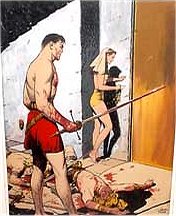 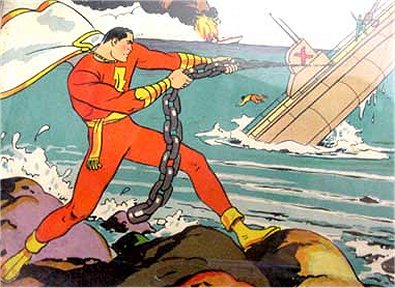 |
Very few people know that this painting exists and fewer people have
ever seen this cover painting. Almost no comic book or pulp collectors
associate C.C. Beck with Edgar Rice Burroughs. Here is the story:
In 1947 C.C. Beck was at odds with Fawcett Publishing Co. Fawcett had published most of Beck's comic book work from 1940 onwards. Beck was the major force behind Captian Marvel and its various spin-off titles. At one point, Captain Marvel was the best selling title during the golden age of comics. Shorty after WWII ended, Beck was looking for other avenues in which to use his talents. Beck wanted to cut ties with Fawcett and he thought he could do a good job of rendering the dust jacket art for Burroughs' series of reprint hardback books. This painting was to be the cover of "THE GODS OF MARS." Unfortunately, this union was not to be made. The blood on Carter and the dead Therns along with Thuvia's topless sensuality were not quite what ERB was looking for at that time. The violence and bloodshed and general mood of this piece were beyond the realm in which Burroughs wanted his creations to be cast. Only one painting was ever made. Note the strong resemblance between John Carter and Beck's favorite character Captain Marvel. |
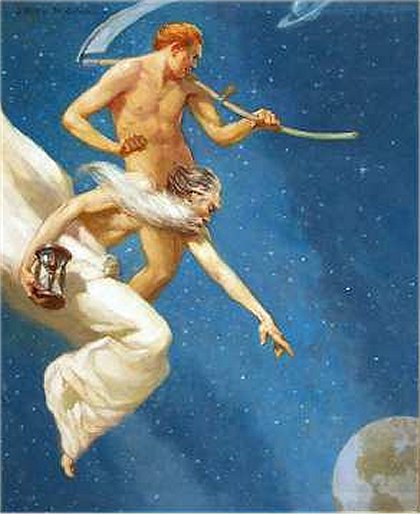 |
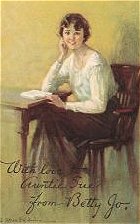 It was published by The Book Supply Company ~ copyright August, 1919. The J. Allen St. John illustrations produced for this volume include one full-color frontispiece plate and three full-color plates throughout the text, all on thick paper. The front cover lettering and decoration, and spine lettering, are in gold ink. |
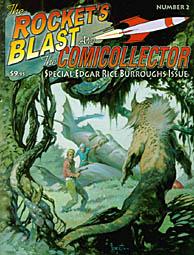
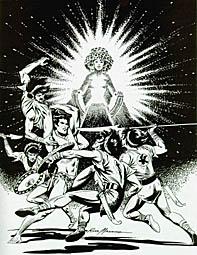 |
ROCKETS BLAST AND THE COMICOLLECTOR 2
Special Edgar Rice Burroughs Issue Edited by James Van Hise. Publisher: Midnight Graffiti, 2001. Soft Cover, 8x11, 128 pages, text/black & white The second volume of the new incarnation of the most famous comics fan magazine of the 1960s and 1970s. Showcasing comicdom's greats, past and present, this starts off with a bang with wonderful full-color covers by Frazetta from the 1960s' Ace paperback covers, here taken from the original paintings! In this special Burroughs issue, Van Hise examines each of the 18 books of the Tarzan in Color series, which collects the strips from 1931-1950. Includes a transcription of a Russ Manning panel from 1999 with Mike Royer, William Stout and Dave Stevens, as well as nine full-page renderings of Tarzan by Manning; a 13-page art folio by Roy Krenkel, Virgil Finlay, J. Allen St. John and Bret Blevins; a six-page sequential art Tarzan mini-story by Dave Hoover; Frank Hoban's art for the serial Tarzan at the Earth's Core as published in Blue Book in 1929-30; a Tarzan screenplay by Gene Roddenberry that never made it to production is discussed; and Van Hise's interview with artist Gary Gianni. |
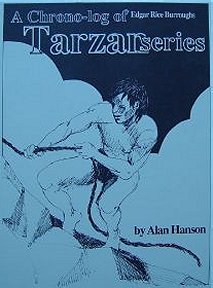 |
CHRONO-LOG OF ERB's TARZAN SERIES
by Alan Hanson Published in 1990 ~ 182 pages ~ spiral bound. Want to know what Tarzan was doing the day the Titanic went down? How did Tarzan spend his fortieth birthday? Then this is the book for you. This is an exhaustive book on the life of Tarzan through the novels. |
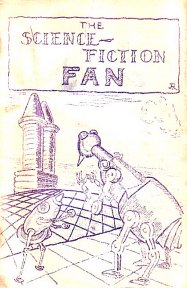 |
THE SCIENCE FICTION FAN (1939 science fiction fanzine) vol. 4 #4, whole number 39. 5 ½ x 8 ½, 20 pages. Ditto printing, some multicolored. Published by Olon F. Wiggins. Associate editor P.J. Searles. Contributing editor Donald A. Wollheim. Features original articles including “The Last of H.P. Lovecraft” by J.B. Michel (5 pages). Article by Ralph Milne Farley on how he and Edgar Rice Burroughs read the same book and were each inspired to write different stories by it (in Farley’s case “The Radio Flyers”). He even quotes a letter he had received from ERB. Article on Stanton A. Coblentz. Article about New York City science fiction fandom by Lawrence Paschall. Also a two page poem by Frederic Pohl titled “Science Fiction Fans, Too, Are Human.” From the collection of Forry Ackerman |
|
Original Illustration Tarzan of the Apes (1991). Here's the story on this magnificent piece,
|
"I was visiting Frank's home many years ago while he was working on his "Kubla Khan" portfolio which was published by Middle Earth in 1977. When I looked closely at his finished pencils for these drawings, I was amazed at the textures and chiaroscuro effects he managed to capture with his pencils. The drawings were stunning! Several months later, visiting again, I looked at these same drawings after he had inked them. They were still great, not in the same category as the Canaverals, but certainly far better than anyone else was doing, and I remarked to Frank that I liked them better as pencils. Frank wasn't sure how to take that: was I praising his talent with the pencil, or was I knocking his inking ability? Finally, he laughed and agreed with me, admitting that his pencil drawings captured a certain feeling that was often not present (to the same degree) in the finished inks. This gave me the idea of commissioning Frank to do a series of large finished pencil drawings for me to use in an illustrated edition of Tarzan of the Apes. Originally, I wanted Frank to do ten to twelve of these for me, for that book. As it turned out, he did only two. This is the second one, showing a giant ape carrying Jane away to his boudoir in the trees, and Tarzan coming to the rescue, complete with gnarly, mossy vegetation and a butterfly." The piece measures 20" x 14", with the image occupying nearly the entire page. |
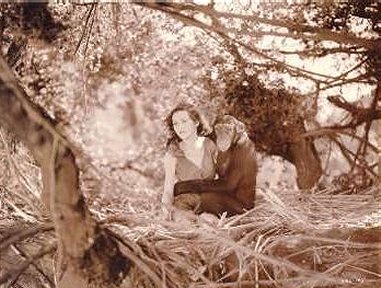
Maureen O'Sullivan and Cheetah |
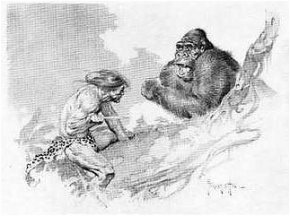
Black and white print of a Frazetta drawing produced by Vern Coriell in 1973. Pebbled paper - 8 1/2" x 11" |
 |
Much of the Science Fiction collection of 82-year-old Forrest J. Ackerman is currently being auctioned off on eBay. Forry Ackerman is one of the great names in science fiction and Hollywood memorabilia. He is perhaps most famous for his editorship of Famous Monsters of Filmland, his representation of SF authors and his spectacular 18-room home which he named Ackermansion. Forry surrounded himself with thousands of books, props, paintings, posters, magazines, stills, etc., this 18 room monsterpiece is a wonder to behold. Sadly, he has had to sell his home due to medical and financial problems and his collection is being dispersed. |
Nobody rescues collection depicting sci-fi era SignOnSanDiego.com
September 20, 2002HOLLYWOOD – For Hollywood and history, it was horrifying. Vultures descended on the estate sale, bickering over prices and carting severed monster heads and space aliens out the landmark mansion's door.
Forrest J. Ackerman, the 85-year-old author and sci-fi king, graciously sat on a fold-out chair and watched his lifelong dream destroyed. Somehow, he managed a smile as strangers grabbed up his late wife's $1 Jell-O molds along with the priceless treasures he'd amassed since he was 10 years old.
For 51 years, almost every Saturday morning and for free, the enthusiastic funster tookwhomever showed up on a lively, chill-filled "touch everything" tour of the "Ackermansion," jampacked with a 300,000-piece movie memorabilia collection once dubbed the "Fort Knox of Science Fiction."
Mostly it was regular folks from around the globe, but A-list celebs, including Bela Lugosi, Vincent Price and Steven Spielberg – the latter who with George Lucas credits Ackerman with inspiring their filmmaking – also ogled at the Martian machine from "The War of the Worlds" and the pteranodon that tried to spirit away Fay Wray in the 1933 "King Kong."
Though he was repeatedly ripped off – some moron even hijacked half of the 18-foot sub from "Atlantis, the Lost Continent" – Ackerman until lately let strangers trek through his bathrooms, bedrooms and kitchen because he wanted to share the gifts and purchases he poured every penny into. But here's the real horror story: For decades,
Forry, as he was nicknamed, futilely tried to get Hollywood studios, moguls and the city of L.A. to give his wondrous wares a permanent home.And now it's too late. Ackerman had to sell the dilapidating 18-room mansion, move into a small nearby bungalow and liquidate the largest collection of its kind in order to pay $200,000 in legal bills incurred during a court battle with former business partner Ray Ferry over the pen name Dr. Acula. Ackerman won but Ferry declared bankruptcy.
"How much is this?" the vultures buzzed as they snatched Forry's beloved fantasy paintings and posters off the walls.
"$25," Ackerman replied.
"Will you take $23?"
Author Ray Bradburydidn't go to the weekend estate sale; he says he would've cried. Ackerman, who was the longtime editor of the pulp magazine, Famous Monsters of Filmland, gave Bradbury his first writing break in 1937.
"It's a disaster. This shouldn't have happened," said Bradbury, who claims that over the years he tried to get everyone from the late Mayor Tom Bradley to Spielberg to help with a museum. "Hollywood has never done anything about itself. They're greedy, selfish and they're stupid!"
Ackerman, who coined the term "sci-fi" in the '50s and created the Vampirella comic, is still recovering from pneumonia and brain surgery to remove a blood clot, but he sat in that fold-out chair all day, autographing every bargain-basement item for free. Once, he seemed on the verge of tears when he turned over a gargoyle figurine to write his name and saw an old message from the fan who gave it to him – "To Forry" next to a heart.
But then, he bravely grinned and addressed the next customer in line. "Can I come and visit your collection sometime with all that great art?" he kindly asked the man buying a sci-fi trove.
Who knows why Hollywood, rapturous for remakes but pathetic at preserving its past, never came through. A rep for Spielberg said he remembered being offered all or part of the collection but that the director "may not have been interested at that time" or that when asked, "it was so casual, in the middle of a movie, that it never got further than that." A spokesman for the Academy of Motion Picture Arts and Sciences said a curator from its library, which has extensive archives on Ackerman, visited his home, but that an "official" proposal was never made and the collection
was too diverse for the academy.Whatever. It's scary.
So instead, there was the ghastly garage sale. Soon, there'll be three auctions, where Forry's 50,000 spine-tingling book collection and other high-end relics go on the block. He did manage to keep about 50 of his most prized mementos, which now surround him in his modest rental.
Before going to the estate sale, the lanky gent put aside his walking cane and hammed it up in a cape that Lugosi donned in a 1932 stage production of "Dracula." (Theatrics come easy – he's had scores of cameos, and laughs that as a teetotaler, he drank apple juice at a bar in "Beverly Hills Cop III"). Next to the dining table, he showed off the teeth and top hat worn by Lon Chaney in the 1927 film "London After Midnight."
"Don't touch it! That will blow us all to Adam!" he jokingly shouted when a reporter neared a mounted electricity switch from the 1935 "Bride of Frankenstein."
Forry has no heirs. "These things are his children," said Ann Robinson, a friend who starred in the 1953 "War of the Worlds."
And, no surprise, this big-hearted creature still wants to share his brood with everyone. Next month, with his live-in nurse at his side and by appointment only, Forry plans to begin giving tours of his new digs. He devilishly smiled; once again he'll joyously spook "victims" with long-lost Hollywood lore.
FORRY'S ESTATE SALE: ANOTHER PERSPECTIVE
Funny, but that's not what I saw. First, the estate sale was announced by Forry, who presided over it and approved the prices which were set. I was there both days, all day, and what I saw were people wanting a piece of history. It stated in the newspaper article in the LA Times which announced the sale that Forry was moving and they had to sell as much as possible or else much of it would have been thrown in the trash. In point of fact a few days later a king size dumpster was set up outside Forry's house to throw away what couldn't be sold or given away, and which was considered not worth saving. I saw the reporter there at the estate sale and I even spoke to her, not that any observations I made wound up in the piece, just her slant.--James Van HiseTake a visit to Forry's Ackermansion ~ as it was in 1999:
http://www.erbzine.com/mag1/0185.html
http://www.erbzine.com/mag1/0186.html



U OF W SELLS HUGE SCI-FI COLLECTION
WebPosted Nov 4 2002 08:16 AM MST
WINNIPEG -
A space squeeze at the University of Winnipeg library... has forced the school to sell one of Canada's largest collections of science fiction books.The collection, which includes more than 30,000 books and periodicals, was willed to the university in the late 1990s by Winnipegger Robert Stimpson.
University librarian Mark Leggott says the collection had been assessed at $250,000. It sold last month to American book dealer L.W. Curry for $140,000.
The university had been storing the collection in a basement storage room at the Greyhound bus terminal because
it didn't have space in its climate-controlled book room."As you know, the University of Winnipeg it tight on space. It would have cost us $400,000 to catalogue and
house the collections, that was space and money that we just never had," he says."Unfortunately, we were storing it in our off-site storage facility, which is not climate-controlled, so the collection would have been disintegrating year by year."
Leggott says most of the classic items in the collection can still be found in the university's library. "For example, the first-edition books that were there, like the Dune, the Herbert books, the Asimov, Edward Rice Burroughs etc.;
they would all be available still today in other editions."Leggott says Curry did leave the university about 4,000 hard cover books from the collection.
 |
Eli Eshed is an Tarzan fan and leading authority on Israeli science fiction, who, in 2000, published a very limited edition of a Hebrew book called TARZAN IN THE HOLY LAND. This book is a history and a bibliography of the Tarzan phenomenon in Israel where there were more then a 1000 original stories about Tarzan. Although it is in Hebrew, it is illustrated throughout with dustwrappers and pictorial bindings from all the main Tarzan series published in Israel. It is then a book of interest even for the majority who do not read Hebrew. Look for more on Eli's work in next week's ERBzine |

Online Archives for Films of the Golden Age.
http://new.filmsofthegoldenage.com/
April 16, 2002
Tarzan the Funny By Tom WeaverDenny Miller has no regrets about playing the title role in MGM's Tarzan, The Ape Man (1959) - even though Leonard Maltin lists the movie as a bomb and Ape Man expert Gabe Essoe, in his book "Tarzan of the Movies," calls it "Tarzan, The Worst." These are blunt, unkind-sounding assessments, but one of the first people who'd agree with them would be Miller, a six-foot-four UCLA star athlete plucked from obscurity and outfitted with the familiar Tarzan loincloth. The Technicolor movie is filled with stock footage from King Solomon's Mines (1950) and other oldies (including some in black and white!), afflicted with a bongo-heavy jazz score, and packs more phony rear-projection and fake animals than you could shake a spear at. It's an embarrassingly minor footnote to MGM's classic Johnny Weissmuller series, but it gave Miller his start as an actor and, much more recently, has helped advance his new career as a physical educator. He recalled his foray into the foliage with great affection in this recent interview.
 |
I am fascinated by your site on Tarzan Radio.
My mother was Karena Shields and my father Fred Shields. Is there any way to get copies of those shows? If you wished I could send a photo and a bio of what they did with their lives. Also, as a child, in the late 30's early 40's I did radio and was on
many of the Lux Radio Theater programs with Orson Wells.
Your site is wonderful. I am grateful for all the research that has gone into it. Lauren Essex
|
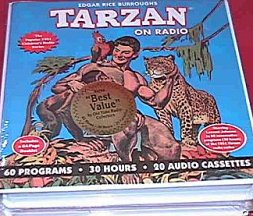 |
ERBzine 0011: Radio's
Golden Age: Tarzan
|
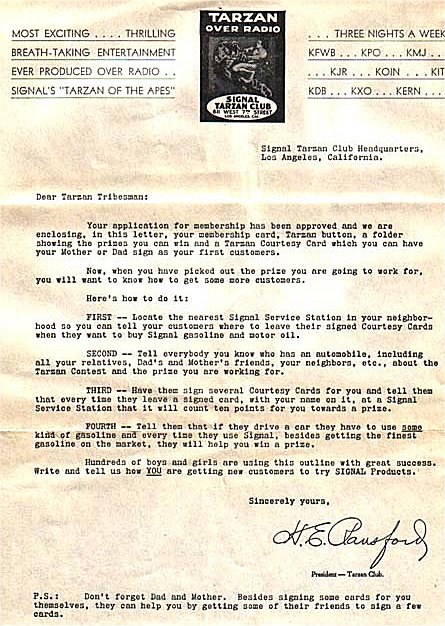 |
One for the show disc, and one for the theme disc. 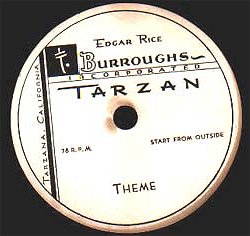
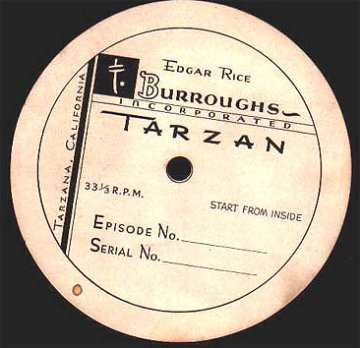 |
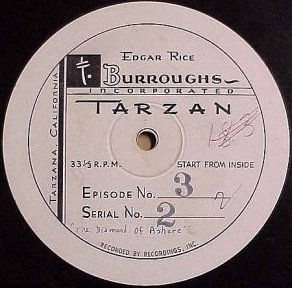
New from Jerry Schneider's ERBville Press
EDGAR RICE BURROUGHS
UNIFORM EDITION HARDCOVER COLLECTION
http://www.angelfire.com/film/locationbooks/erb.htm
Now on Sale!
The First Edition of
"The Girl From Farris's"
$34.95 plus shipping
Click
Here To Order
Contact: jerry@oxy.edu
Read ERB
Stories in PDF Format
![]()
![]()
Volume
0987

WEBJED:
BILL HILLMAN
Visit
our thousands of other sites at:
BILL
AND SUE-ON HILLMAN ECLECTIC STUDIO
All
ERB Images© and Tarzan® are Copyright ERB, Inc.- All Rights Reserved.
All
Original Work © 1996-2002/2010 by Bill Hillman and/or Contributing
Authors/Owners